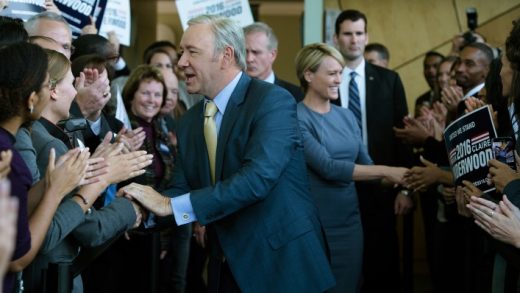8 Things We Learned About House Of Cards Season 5 From Its New Showrunners
The fourth season of House of Cards found President Frank Underwood (Kevin Spacey) and his wife/running mate, Claire (Robin Wright), actively on the campaign trail, working against assassination attempts and terrorist organizations to realize their goal of a two-term presidency. When the season ended, the actual American election had just hit the primaries–and the Underwoods were still three weeks away from Election Day.
Yet in the nearly 15 months since Netflix’s flagship series released new episodes, the American people endured a grueling general election, an unprecedented victory, and an exhaustive 100 first days in a fledgling–and woefully inept–administration. And behind the scenes, the show saw its own transition of power when series creator Beau Willimon stepped down as showrunner, making room for Melissa James Gibson and Frank Pugliese to serve as co-showrunners in his stead.
Both writers on the show since the third season, Gibson and Pugliese found themselves in the unique position of having to build upon last season’s cliffhanger ending while coming up with a fifth season that wouldn’t pale in comparison to true life politics–something that hadn’t been a concern until now. Here, Fast Company speaks with the new House of Cards showrunners about learning on the job and writing against a (somewhat) real-world Underwood-ian president.
Having a theater background is helpful for any rookie showrunner
The biggest challenge, as with any new career move, was wrapping their heads around the scope of responsibilities involved with running such a series. “In this job, it’s a real skill to manage time and creative decisions that are getting made on a daily basis–and especially how you manage the time you should give to each decision,” Pugliese says. “Luckily, Melissa and I come from the theater, where we’re used to collaborative processes. I ran a theater company for a while, too, so that was helpful in a way because there, you’re in collaboration with large groups and you get used to seeing how each decision gets made.”
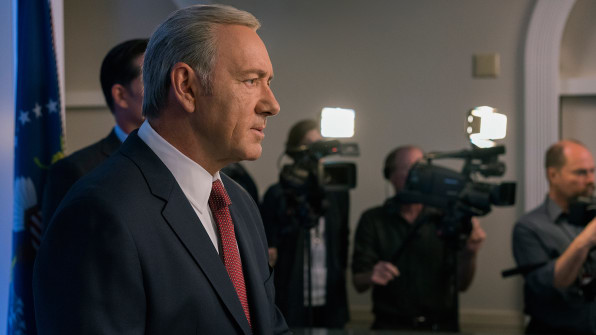
Like in politics, there was a peaceful transfer of power
For all the drama that unfolds onscreen, the changing of the guard behind the scenes was actually far less dramatic. Because the writers’ room moved down to the shooting location in Baltimore for the third and fourth seasons, Gibson and Pugliese had two years’ worth of being on set in a limited capacity–the perfect means of getting to know the cast and crew. “It’s a really well-oiled machine,” Gibson says of Netflix’s setup. “The transition was really seamless because we’d worked with everyone in the past.”
Surprisingly (and perhaps most importantly), everyone involved in production–“the whole gamut,” Pugliese stresses–seemed as invested in season five as they were from the get-go. “There’s an allegiance that comes from just everyone being clear that we’re all trying to make the best episode of television we can,” he says. “Once that’s understood, everybody’s onboard.”
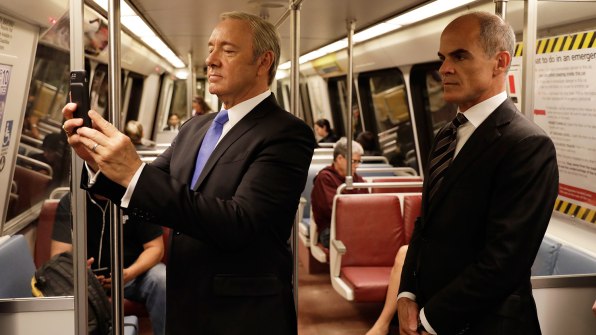
Season five is all about “terror and fear”
The fifth season premiere seems to possess more kinetic energy than the average House of Cards episode, moving faster through plot points thanks to the high-stakes ending of season four. When viewers last saw them, Francis “Frank” and Claire Underwood (Kevin Spacey and Robin Wright) were on the verge of fomenting chaos and “basically threatening World War III.”
The challenge for the new showrunners, then, was coming up with a means of saving the Underwoods from the corner they’ve been backed into. Their ultimate solution felt eerily appropriate. “We came to this idea of playing with terror and fear, and how it’s manipulated and how it plays out in the imagination of the American people,” Pugliese says. “I mean, probably the most terrifying place is inside the imagination when it comes to terror.”
“To us, that felt very Underwood-ian,” Gibson adds.
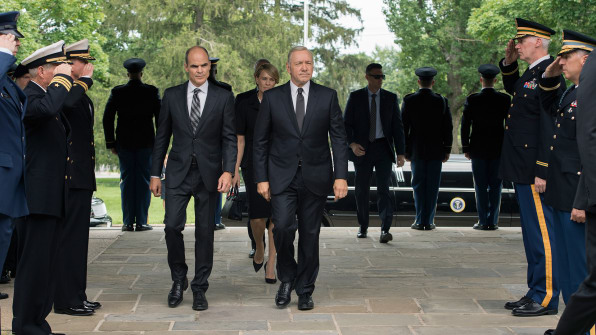
There was no temptation to reboot
Despite being handed near-absolute creative authority over the series, Gibson and Pugliese felt no compulsion to shake things up or course-correct plotlines from seasons past. “We came in at a point where there was a number of stories that were already in motion,” Pugliese says, offering Underwood chief of staff Doug Stamper’s storyline as one of several demanding follow-through. “How we juggle them and how we tell the story is our decision, but a lot of that was already in play. And we were being responsible to what had come in the four previous seasons.”
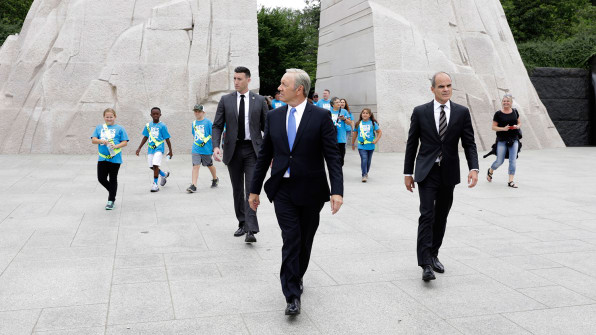
Season five was written before Trump was elected…
Ever since the shocking election results in November, Gibson and Pugliese have understood the natural inclination to draw parallels between the soap-opera-meets-politics elements of House of Cards and the real world. Yet despite whatever similarities viewers might divine from this new season, the truth is that season five had already been broken and finished months before Trump would unexpectedly win the election. “We were actually shooting episodes 10 and 11 by that time,” Gibson clarifies.
Thanks to the disparate timelines–season five picks up in the middle of the general election–writers had little room to either re-tool or scrap ideas entirely. “If any changes happened, they were in the moment,” Pugliese says. “Maybe a line of dialogue here and there. But as far as the story and everything we had laid out, it basically stuck to what we had laid out months before the election happened.”

…but they foresaw Trump’s rise to power
While House of Cards’s writers couldn’t have predicted or used specifics from the Trump administration for the series, their rigorous news consumption and regular consultation with political experts kept them in touch with global goings-on, both culturally and politically. By Gibson and Pugliese’s account, that’s what makes this season–which kicks off with a fictional tightening of border security, not unlike Trump’s restrictions–so eerily relevant.
“We were just feeding off the same stuff that might’ve created Trump,” Pugliese says. “That stuff was in the air and had been in the air for a while. Any similarities exist because the conditions are similar. In a way, nationalism and populism is something we’ve been talking about and playing with since season three. This idea that a figure might come along and take advantage of that. For us, it’s Francis. In the real world, it’s someone else.”
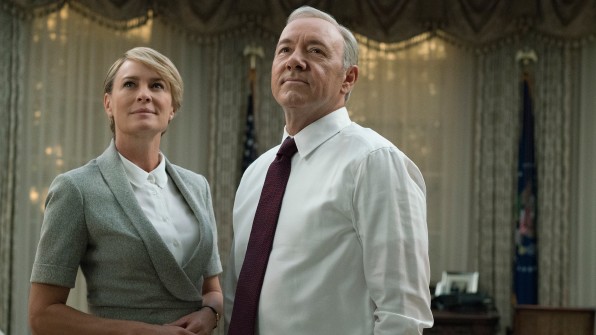
Frank and Claire’s marriage takes center stage once again
The first 100 days of Trump’s presidency had been so outlandish that it almost seemed impossible for House of Cards–still caught mid-election–to keep up with the pace of the real world. And while there was some worry about coming back while viewers were otherwise preoccupied, Gibson and Pugliese acknowledge they had no choice but to tell the story they promised to tell. And while the series won’t be able to avoid looking politically uninspired next to the current administration, it plans on playing up one of its more entertaining and foundational elements.
“We have to respond to the zeitgeist at a certain level, sure, but the other thing that’s at the heart of the show is this fascinating marriage,” Gibson says. Where seasons three and four watched the White House couple drift apart and scheme separately, season five puts the emphasis back on Frank and his Lady Macbeth together. “We have to serve the political landscape on one hand, but that relationship and the power struggle between them, in context, is really part of the show’s heartbeat.”
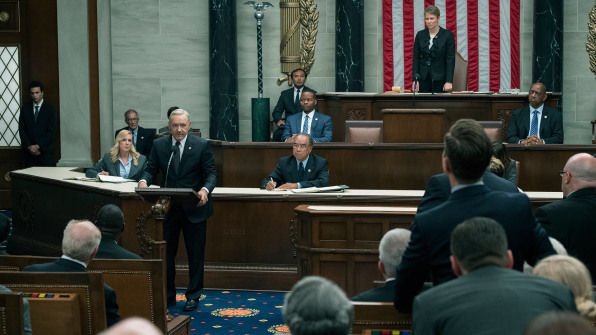
Similarities between Underwood and Trump haven’t gone unnoticed
The series’s central Machiavellian politico seems all the more sinister when mirrored against Trump. Both have a proclivity for theatricality and distraction tactics, not to mention an unsettling sense of doing whatever it takes for the sake of getting what they want. But the similarities, Pugliese says, stop there. “Both characters are just responding in the moment, but ultimately, they’re different,” he says. “Francis operates on the inside, and Trump operates on the outside. One thing that I will concede is how they might do anything or say anything for the sake of power. Those are similarities that are scary to see, but the way they do it is fundamentally different.”
If anything, Gibson says today’s real world political climate presents an opportunity of introspection for House of Cards‘s viewers. “Francis has asked for the audience’s complicity from the very beginning of the series,” she says. “And part of what the show is doing this season is taking that to its outer limits. It’s asking: How far are you willing to go along? How complicit will you be? And I do think that that’s a question that has resonance in the real world. If it makes you question what’s going on in the world around you, then great.”
Melissa James Gibson and Frank Pugliese discuss going full “Underwood-ian” in the latest season of Netflix’s flagship series.
The fourth season of House of Cards found President Frank Underwood (Kevin Spacey) and his wife/running mate, Claire (Robin Wright), actively on the campaign trail, working against assassination attempts and terrorist organizations to realize their goal of a two-term presidency. When the season ended, the actual American election had just hit the primaries–and the Underwoods were still three weeks away from Election Day.
Fast Company , Read Full Story
(75)

